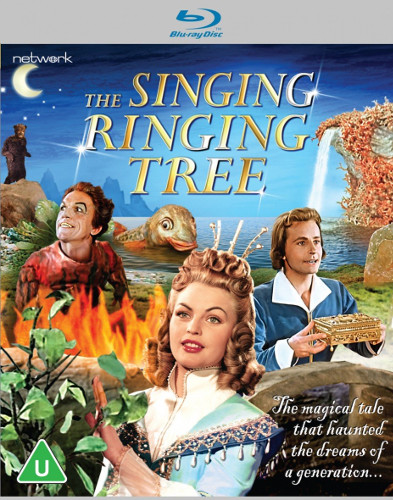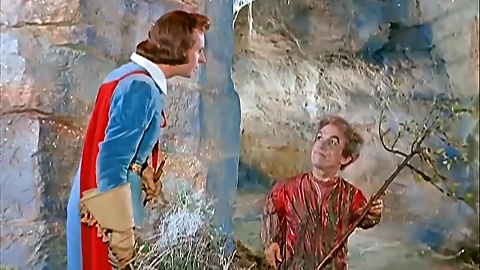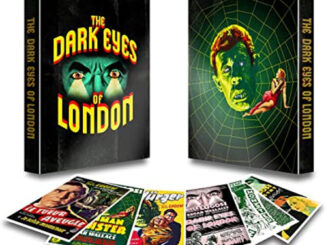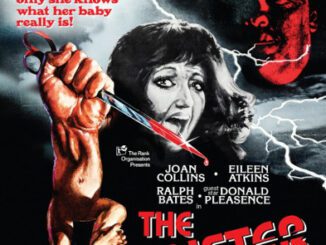The Singing Ringing Tree (1957)
Directed by: Francesco Stefani
Written by: Anne Geelhaar, Francesco Stefani, Jacob Grimm, Wilhelm Grimm
Starring: Charles Hans Vogt, Christel Bodenstein, Eckart Dux, Richard Krüger
AKA DAS SINGENDE, KLIGENDE BAUMCHE
EAST GERMANY
AVAILABLE ON BLU-RAY: 18TH OCTOBER, from NETWORK RELEASING
REVIEWED BY: Dr Lenera

A beautiful but selfish and haughty princess rejects the proposal of a wealthy prince. She scorns the gift he offers her, and says that she will marry him only if he brings her the mythical “singing ringing tree”. The prince locates the tree in the territory of an evil dwarf, who offers to give it to him on the understanding that, if the princess doesn’t fall in love with the prince by sundown, he will be in the dwarf’s power and will be turned into a bear. Because the tree will only sing and ring when the princess falls in love with the prince, she’s disappointed in it and rejects the prince again….

We all vividly recall films and programmes that terrified us as a young kid. Mine range from the original Invaders From Mars [is there anything more frightening for a child than seeing a flying saucer landing in his back garden, having his or her parents being acting creepily different due to being taken over, and nobody believing him?] to Salem’s Lot [that boy at the window moving like he’s a puppet on strings]. Even things ostensibly intended for younger viewers can scar, and one of these is The Singing Ringing Tree, though I never came across it until now. A Radio Times readers’ poll in 2004 voted it the 20th spookiest TV show ever, while the subject even formed the basis of a BBC Radio 4 documentary. Now I’m going to be honest right away – while I watched it, I found it hard to see why why it haunted so many. The sinister dwarf, which seems to be the thing that scared viewers most, has some unnerving looks, but I can’t imagine him having given me any sleepless nights when I was little. That’s not to say that the film is not worthy of viewing or purchasing though; in fact I’d love it if some parents bought it and showed it to their children – well, as long as the latter aren’t already addicted to CGI and rapid cutting in which case it may be too late. But this is a rather enchanting little fantasy, totally devoid of the cynicism or sops to political correctness that it would probably have if it were made now, though saying that it’s great and unusual for the time to have a princess who has a full character arc. There’s an appealing honesty and a simple purity about it as it tells its tale as if it were really worth telling, and for me suffers from only one major flaw which stems not from the narrative but the way a part of the narrative is handled, or rather the way a certain character is depicted in one major section.
It was loosely based on one of Grimm’s Fairy Tales tales called Hurleburlebutz that was omitted from some later editions. Like many of such stories, it’s quite dark and twisted, about a king who’s helped by a dwarf when lost in a forest. The dwarf demands that the king gives his daughter to him as payment but the king decides to dress a poor girl up as his daughter instead. Delousing, women who go off to live with foxes, and a dove being decapitated – one can’t imagine Disney ever considering this to adapt. This film was was made as part of a series of Märchenfilme – that is, fairy tale movies adapted from Brothers Grimm stories – by East Germany’s DEFA, and shot in colour entirely in the studio in Potsdam, Brandenburg. While the former was the one who’s name appeared on the credits, there was later confusion as to whether the actor who played the dwarf was named Richard Krüger and died in Strasbourg, or was Hermann Emmrich who died in 1995 and is buried in Prenzlau. It’s now thought that they were one and the same person. In 1968 the film was picked up by the BBC and presented as a three-part series as part of Tales from Europe, the 74-minute movie split into roughly equal-length episodes for presentation in the children’s TV slot. Depending in your source, it was either properly converted to black and white – colour TV was still a few years away in Britain –or just broadcast as black and white. It was not dubbed. Instead, the original soundtrack was dialed down while a narrator named Antony Bilbow spoke over it. It was repeated many times through all the way to 1980, the black and white at some point being replaced with colour.
Network Releasing’s Blu-ray contains both the German and the English versions, and I wondered which would be the one available for us writers to view. I generally prefer to see films in their original format, but then the English version is the one that supposedly scared so many. It’s the latter that was put up for us to watch, and it takes a few minutes to get used to this narrator not just telling us what people are saying [though not in exact detail so that every German word is translated] but what they’re doing, while we can still often hear German being spoken, if only quietly. But then a lot of children’s programmes relied on narrators and probably still do. Something else that modern, adult [or even child] viewers will have to get used to is the deliberate artificiality, the film opening with a drawing of a sun setting while the prince rides across a landscape that is about as unmistakably a set as you can get – but, again, this was intended for children, and little in the CGI-dominated Star Wars prequels looks real either. The prince stops at a tree and feeds his horse some hay before falling asleep. When he awakes, he travels onward until some men welcome him as a suitor for the land’s princess. In court, the king likes the visitor but the princess snatches his box from him and lets the gems within pour onto the floor. Yes, this is a princess who we really don’t like at all, a really arrogant, rude sort, and this undercuts the glorification of the aristocracy that so many fairy tales have. Asked if there’s a gift he can bring her that she’ll like, the princess plucks out of thin air the Singing Ringing Tree, a “magic tree that dispels all evil”. Nobody knows where this fabled plant is, and the prince is amusingly sent from person to person in his quest to find it. Finally he arrives at a mountain cave inhabited by a dwarf who pulls out and hides behind a tiny tree so the prince can’t see him, though his efforts to take him by surprise fail.

Behind a small cobwebbed tunnel lies a grotto, a truly beautiful set that may make you want to pause the film so that you can admire it properly. The dwarf produces this rather pathetic-looking thing considering that it’s supposed to be am amazing mythical object [maybe that’s the point] and the prince rashly says “may I turn into a bear if it doesn’t happen like that”, referring to the need for and to him the more than distinct possibility of the princess falling in love with him. She’s one arrogant cow who will not just pretend to cry if it means that she’ll get her own way, but isn’t nice to animals, shoeing doves out of her room and even letting the water out of a fish pond so the tree can be planted there. After sending the poor prince away again, she decides that she quite fancies his intended gift as it may indeed be the Singing Ringing Tree, and sends her father the king out to get it for her. “I must have it”! The prince does indeed turn into a bear in a simple but nicely done effect that begins with the feet then moves upwards, while his horse becomes a stone sculptor. Of course it’s a suit, but with a face resembling Lon Chaney’s Wolf Man. The king offers the prince in his bear form his kingdom, but the latter is happy to just give over the tree on condition that the king returns with the first thing the king sees on his return – which turns out to be the princess, who’s now delivered into the hands of the dwarf. What then follows is basically a variant on Beauty And The Beast as a human female has to fall in love with a male that’s not human at all, and here it’s a flipping bear, though what really adds interest is that the princess also has to learn to become a better person, and don’t we always like seeing that?
The end result is never in doubt, but we still want to see exactly how things will be shown, and I bet 1968 TV viewers, not to mention 1957 German ones, would have been surprised by the princess becoming basically the hero in the climax, facing off with the villain. Compare her with, say, the decidedly wet and wimpish Aurora in Disney’s Sleeping Beauty from two years later. Actress Christel Bodenstein makes her bravery seem convincing and is very good at acting emotions with the direct vividness necessary for a film of this nature without coming across as hammy. After a while we don’t miss not hearing her speak, nor indeed anybody else. I wouldn’t be surprised if some PC-minded critics have taken the film to task for its wicked dwarf, though like it or not little people are frequently depicted like this in old fairy tales, and it looks like Kruger had a ball playing the part. He has a knack for rather disturbing expressions, though at times we’re not entirely sure what the motivations are for some of his actions. However, the only issue I really had is a section where the princess is turned ugly. She’s given green hair but quite frankly doesn’t look ugly at all, just has a much plainer face. The makeup is very good, but would it not be better if she looked hideous, and isn’t this rather insulting to ladies who are just averagev looking? Yet it’s possible that this was done to highlight yet again the unpleasantness of the princess, which extends to vanity, so that what she sees as ugliness at all isn’t really ugliness at all – though even then it may have worked better if we were able to see the princess looking far worse than she does otherwise when she looks at herself in the mirror. While the way this was done in the film didn’t really work for me, it’s fair to say that some probably won’t be bothered by it, and the story is strong enough that we can imagine her looking horrid, much like with dated or poor special effects in otherwise really good films where our minds can make up for what’s lacking in the visuals.
Myself, I had no problem with the visuals in this movie seeing as we’re in a fairy tale world. We know we’re seeing model scenery. We know that a giant fish is a mechanical model. We know that a painting of the king’s castle isn’t even a matte painting, just a normal painting. But it doesn’t matter in context, and we can appreciate the artistry. And we do get to see actual real doves being handled which probably wouldn’t happen today seeing as CGI has evolved to allow for realistic depiction of animals; there’s no way that they would have used real doves for the small amount of screen time they’re in if this was made today. It’s sometimes strange the way things have gone, though it’s just as strange – and in a good way – how travel is depicted here. On some instances, especially in the first third, we’re transported from the beginning of a journey to the end by a rock or a tree looming in the foreground and covering the screen for a second. Time frames are all over the place, this being a world where a journey of the same distance can sometimes seem to take many days and sometimes a few hours. Rather than attempting a realistic evoking of lengthy traveling that may have been beyond the budget anyway, director Francesco Stefani and company happily play with time instead which is something many fairy tales do anyway because it’s always the tale that’s most important, and then its meaning, not realistic details. Heinz-Friedel Heddenhausen’s musical score has some nice themes which become more dominant in the second half, even if it never becomes outstanding, and I’m sure that The Singing Ringing Tree has never looked better in Network’s quite striking release – no faded colours here. Treat yourself and your kids to this beguiling fable. I don’t think it will frighten, but it may cast a spell.
Rating: 









SPECIAL FEATURES
Widescreen theatrical version with German audio or alternative music-only soundtrack
Fullscreen version with English narrated soundtrack or alternative French and Spanish soundtracks
Interview with a Princess: a 2003 interview with Christel Bodenstein
Image Gallery
Limited edition booklet by cultural historian Tim Worthington




Be the first to comment